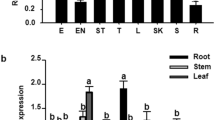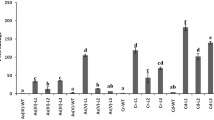Abstract
Phytochelatins (PCs) are heavy metal binding peptides that play an important role in sequestration and detoxification of heavy metals in plants. In this study, our goal was to develop transgenic plants with increased tolerance for and accumulation of heavy metals from soil by expressing an Arabidopsis thaliana AtPCS1 gene, encoding phytochelatin synthase (PCS), in Indian mustard (Brassica juncea L.). A 35S promoter fused to a FLAG–tagged AtPCS1 cDNA was expressed in Indian mustard, and transgenic lines, designated pc lines, were evaluated for tolerance to and accumulation of Cd and Zn. Transgenic plants with moderate AtPCS1 expression levels showed significantly higher tolerance to Cd and Zn stress, but accumulated significantly less Cd and Zn than wild type plants in both shoot and root tissues. However, transgenic plants with highest expression of the transgene did not exhibit enhanced Cd and Zn tolerance. Shoots of Cd-treated pc plants had significantly higher levels of phytochelatins and thiols than wild-type plants. Significantly lower concentrations of gluthatione in Cd-treated shoot and root tissues of transgenic plants were observed. Moderate expression levels of phytochelatin synthase improved the ability of Indian mustard to tolerate certain levels of heavy metals, but at the same time did not increase the accumulation potential for Cd and Zn.






Similar content being viewed by others
Abbreviations
- GSH:
-
Gluthatione
- NPT:
-
Non protein thiols
- PCs:
-
Phytochelatins
References
Anderson ME (1985) Determination of glutathione and glutathione disulfide in biological samples. Meth Enzymol 113:548–555
Bennett LE, Burkhead JL, Hale KL, Terry N, Pilon M, Pilon-Smits EA (2003) Analysis of transgenic Indian mustard plants for phytoremediation of metal-contaminated mine tailings. J Environ Qual 32:432–440
Bergmann L, Rennenberg H (1993) Gluthatione metabolism in plants. In: De Kok LJ, Stulen I, Rennenberg H, Brunold C, Rauser WE (eds) Sulfur nutrition and sulfur assimilation in higher plants. SPB Academic Publishers, The Hague, Netherland, pp 109–123
Blaylock MJ, Salt DE, Dushenkov S, Zakharova O, Gussman C, Kapulnik Y, Ensley BD, Raskin I (1997) Enhanced accumulation of Pb in Indian mustard by soil-applied chelating agent. Environ Sci Technol 31:860–865
Bradford MM (1976) A rapid and sensitive method for the quantitation of microgram quantities of protein utilizing the principle of protein dye binding. Ann Biochem 72:248–254
Chen YX, He YF, Yang Y, Yu YL, Zheng SJ, Tian GM, Luo YM, Wong MH (2003) Effect of cadmium on nodulation and N2-fixation of soybean in contaminated soils. Chemosphere 40:781–787
Clemens S, Kim EJ, Neumann D, Schroeder JI (1999) Tolerance to toxic metals by a gene family of phytochelatin synthases from plants and yeast. EMBO J 18:3325–3333
Cobbett CS (2000) Phytochelatins and their roles in heavy metal detoxification. Plant Physiol 123:825–832
Creissen G, Firmin J, Fryer M, Kular B, Leyland N, Reynolds H, Pastori G, Wellburn F, Baker N, Wellburn A, Mullineaux P (1999) Elevated gluthatione biosynthetic capacity in the chloroplasts of the tobacco plants paradoxically causes increased oxidative stress. Plant Cell 11:1277–1291
De Vos RCH, Vonk MJ, Voojis R, Schat H (1992) Gluthatione depletion due to copper-induced phytochelatin synthesis causes oxidative stress in Silene cucubalus. Plant Physiol 98:853–858
Ebbs SD, Lau I, Ahner B, Kochian L (2002) Phytochelatin synthesis is not responsible for Cd tolerance in the Zn/Cd hyperaccumulator Thlaspi caerulescens (J. and C. Presl). Planta 214:635–640
Ellman GL (1959) Tissue sulfhydryl groups. Arch Biochem Biophys 82:70–77
Fassel VA (1978) Quantitative elemental analyses by plasma emission spectroscopy. Science 202:183–191
Gasic K, Korban SS (2005) Nonspecific binding of monoclonal anti-flag M2 antibody in Indian mustard (Brassica juncea). Plant Mol Biol Rep 23:9–16
Gasic K, Korban SS (2006) Heavy metal stress. In: Madhava Rao KV, Raghavendra AS, Janardhan Reddy K (eds) Physiology and Molecular Biology of Stress Tolerance in Plants. Springer, Berlin Heidelberg New York, pp 219–254
Gisbert C, Ros R, de Haro A, Walker DJ, Bernal MP, Serrano R, Navarro-Aviñó J (2003) A plant genetically modified that accumulates Pb is especially promising for phytoremediation. Biochem Biophys Res Commun 303:440–445
Greger M, Löfstedt M (2004) Comparison of uptake and distribution of Cd in different cultivars of bread and durum wheat. Crop Sci 44:501–507
Grill E, Löffler S, Winnacker E-L, Zenk MH (1989) Phytochelatins, the heavy-metal-binding peptides of plants, are synthesized from glutathione by specific (-glutamylcysteine dipeptidyl transpeptidase (phytochelatin synthase). Proc Natl Acad Sci USA 86:6838–6842
Gupta SC, Goldsbrough PB (1991) Phytochelatin accumulation and cadmium tolerance in selected tomato cell lines. Plant Physiol 97:306–312
Hartley-Whitaker J, Ainsworth G, Mehrang AA (2001) Copper and arsenate-induced oxidative stress in Holcus lanatus L. clones with differential sensitivity. Plant Cell Environ 24:713–722
Heiss S, Wachter A, Bogs J, Cobbett C, Rausch T (2003) Phytochelatin synthase (PCS) protein is induced in Brassica juncea leaves after prolonged Cd exposure. J Exp Bot 54:1833–1839
Kumar PBAN, Dushenkov V, Motto H, Raskin I (1995) Phytoextraction: the use of plants to remove heavy metals from soils. Environ Sci Technol 5:1232–1238
Lee S, Moon JS, Ko TS, Petros D, Goldsbrough PB, Korban SS (2003a) Overexpression of Arabidopsis phytochelatin synthase paradoxically leads to hypersensitivity to cadmium stress. Plant Physiol 131:656–663
Lee S, Petros D, Moon JS, Ko TS, Goldsbrough PB, Korban SS (2003b) Higher levels of ectopic expression of Arabidopsis phytochelatin synthase do not lead to increased cadmium tolerance and accumulation. Plant Physiol Biochem 41:903–910
Leopold I, Günther D, Schmidt J, Neumann D (1999) Phytochelatins and heavy metal tolerance. Phytochemistry 50:1323–1328
Li Y, Dhankher OP, Carreira L, Lee D, Chen A, Schroeder JI, Balish RS, Meagher RB (2004) Overexpression of phytochelatin synthase in arabidopsis leads to enhanced arsenic tolerance and cadmium hypersensitivity. Plant Cell Physiol 45:1787–1797
Murashige T, Skoog T (1962) A revised medium for growth and bioassays with tobacco tissue cultures. Physiol Plant 15:473–479
Murphy A, Taiz L (1995) A new vertical mesh transfer technique for metal-tolerance studies in arabidopsis: ecotypic variation and copper sensitive mutants. Plant Physiol 108:29–38
Máthé-Gáspár G, Anton A (2005) Study of phytoremediation by use of willow and rape. Acta Biol Szeged 49:73–74
Nriagu JO, Pacyna JM (1998) Quantitative assessment of worldwide contamination of air, water and soils with trace metals. Nature 333:134–139
Pilon-Smits EAH, Hwang S, Lytle CM, Zhu Y, Tai JC, Bravo RC, Chen Y, Leustek T, Terry N (1999) Overexpression of ATP sulfurylase in Indian mustard leads to increased selenate uptake, reduction, and tolerance. Plant Physiol 119:123–132
Raskin I, Smith RD, Salt DE (1997) Phytoremediation of metals: using plants to remove pollutants from the environment. Curr Opin Biotech 8:221–226
Salt DE, Prince RC, Pickering IJ, Raskin I (1995) Mechanisms of cadmium mobility and accumulation in Indian mustard. Plant Physiol 109:1427–1433
Schäfer HJ, Haag-Kerwer A, Rausch T (1998) cDNA cloning and expression analysis of genes encoding GSH synthesis in roots of the heavy metal accumulator Brassica juncea L.: evidence for Cd-induction of a putative mitochondrial γ-glutamylcysteine synthase isoform. Plant Mol Biol 37:87–97
Van Huysen T, Abdel-Ghany S, Hale KL, LeDuc D, Terry N, Pilon-Smits EA (2003) Overexpression of cystathionine-gamma-synthase enhances selenium volatilization in Brasica juncea. Planta 218:71–78
Vatamaniuk OK, Mari S, Lu YP, Rea PA (1999) AtPCS1, a phytochelatin synthase from Arabidopsis: isolation and in vitro reconstitution. Proc Natl Acad Sci USA 96:7110–7115
Vatamaniuk OK, Mari S, Lu YP, Rea PA (2000) Mechanism of heavy metal ion activation of phytochelatin (PC) synthase. J Biol Chem 275:31451–31459
Vatamaniuk OK, Mari S, Lang A, Chalasani S, Demkiv OL, Rea PA (2004) Phytochelatin synthase, a dipeptidyktransferase that undergoes multisite acylation with γ-glutamylcysteine during catalysis. J Biol Chem 279:22449–22460
Zarcinas BA, Cartwright B, Spouncer LR (1987) Nitric acid digestion and multi-element analysis of plant material by inductively coupled plasma spectrometry. Commun Soil Sci Plant Anal 18:131–146
Zenk MH (1996) Heavy metal detoxification in higher plant—a review. Gene 179:21–30
Zhu YL, Pilon-Smiths EAH, Jouanin L, Terry N (1999a) Overexpression of glutathione synthetase in Indian mustard enhances cadmium accumulation and tolerance. Plant Physiol 119:73–79
Zhu YL, Pilon-Smiths EAH, Tarun AS, Weber SU, Jouanin L, Terry N (1999b) Cadmium tolerance and accumulation in Indian mustard is enhanced by overexpressing γ(-glutamylcisteine synthetase. Plant Physiol 121:1169–1177
Acknowledgments
We would like to thank Dr. Norman Terry for supplying us with Indian mustard seed, including transgenic line GS7, and Dr. Peter Goldsbrough for helping us with PCs analyses. This work was funded by a grant received from the Illinois Department of Natural Resources.
Author information
Authors and Affiliations
Corresponding author
Rights and permissions
About this article
Cite this article
Gasic, K., Korban, S.S. Expression of Arabidopsis phytochelatin synthase in Indian mustard (Brassica juncea) plants enhances tolerance for Cd and Zn. Planta 225, 1277–1285 (2007). https://doi.org/10.1007/s00425-006-0421-y
Received:
Accepted:
Published:
Issue Date:
DOI: https://doi.org/10.1007/s00425-006-0421-y




